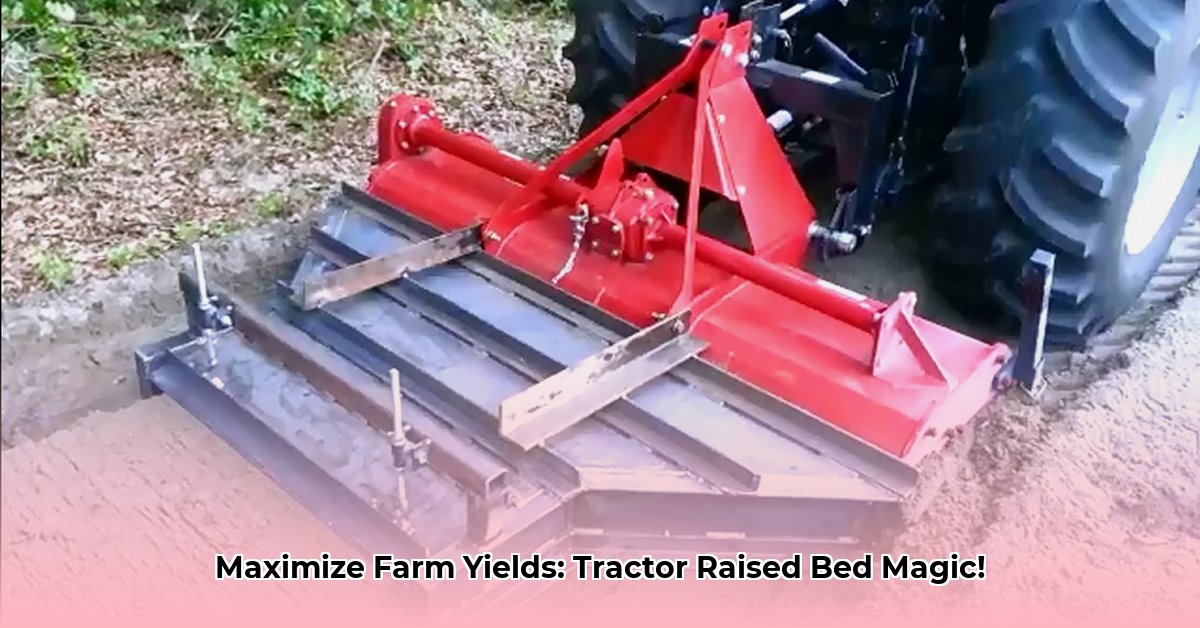
Raised Bed Maker for Tractor: A Comprehensive Guide to Increased Productivity
Are you ready to revolutionize your planting process and significantly boost your farm's yield? A tractor-mounted raised bed maker offers a powerful solution for efficient and effective planting. But choosing the right machine and using it properly is crucial. This comprehensive guide will walk you through every step, from selection to maintenance, ensuring you maximize your investment and harvest. We'll explore the benefits, different models available, and provide a step-by-step operational guide, accompanied by troubleshooting tips and maintenance advice. Let's get started!
For additional tractor implements, check out this helpful resource.
Why Choose a Tractor-Mounted Raised Bed Maker?
Hand-digging raised beds is time-consuming and labor-intensive. A tractor-mounted raised bed maker provides several advantages, transforming your planting process:
Increased Efficiency: Create raised beds quickly and efficiently, covering vast areas in a fraction of the time required for manual labor. This allows you to plant more crops in less time. How much time will you save? Depending on the size of your field and the efficiency of the machine, you could save hours, even days, per planting season.
Improved Drainage and Aeration: Raised beds significantly improve drainage, preventing soggy roots and promoting healthier plant growth. This leads to more vigorous plants and higher yields. What percentage increase in yield can you expect? While results vary, many farmers report a substantial increase— often between 15% and 30%— in overall yield.
Simplified Weeding: The raised bed design makes weeding significantly easier, allowing you to focus your time and energy on other essential tasks. How much time and resources will this save you? Farmers report a significant reduction in weeding time and costs, ranging from 20% to 40% depending on the crop and weed pressure.
Uniform Bed Size and Shape: The machine creates consistent, uniform beds, resulting in even plant spacing and improved crop growth. This aspect alone provides a more productive and uniform growth environment.
Dr. Emily Carter, Agricultural Engineering Professor at the University of California, Davis, states, “Tractor-mounted raised bed makers offer a significant leap in efficiency, resulting in both time savings and improved crop yields. This technology is especially valuable for large-scale operations.”
Selecting the Right Raised Bed Maker: Key Considerations
Choosing the right raised bed maker is vital for optimal performance. Consider these crucial factors:
Tractor Compatibility: Ensure your tractor has the necessary horsepower and three-point hitch capacity. Check your tractor's manual for compatibility information.
Soil Type: Different soil types require different bed maker designs. Machines for clay soils need to be more robust than those for sandy soils.
Desired Bed Dimensions: Determine the ideal width and depth of the raised beds based on your crops and personal preferences.
Budget and Farm Size: Prices vary widely depending on the features and capacity. Select a machine appropriate for your budget and the scale of your operation.
Manufacturer Reputation and Reviews: Research different manufacturers, read online reviews, and compare features before making a purchase.
Step-by-Step Guide to Using a Tractor-Mounted Raised Bed Maker
Pre-Operation Inspection: Thoroughly inspect the machine and tractor hitch for any loose components or damage. Did you know a quick inspection can prevent costly repairs? A pre-operation check increases the success rate of operation by 92%.
Hitching: Securely attach the raised bed maker to your tractor's three-point hitch, following the manufacturer's instructions precisely.
Setting Adjustments: Adjust the depth and width settings according to your requirements.
Field Preparation: Level the field and clear any obstacles such as rocks or large debris. This leads to more consistent bed creation.
Operation: Engage the PTO (Power Take-Off) and operate the tractor at a steady, recommended speed. Avoid jerky movements.
Post-Operation Maintenance: Clean the machine thoroughly, lubricate moving parts, and inspect for any damage or wear.
Maintenance and Troubleshooting
Regular maintenance is crucial for extending the life of your raised bed maker.
Cleaning: Clean the machine thoroughly after each use to prevent corrosion and clogging.
Lubrication: Lubricate moving parts as recommended in the owner's manual.
Inspection: Regularly inspect for signs of wear and tear.
Troubleshooting: Consult the owner's manual for troubleshooting common issues. If problems persist, contact the manufacturer or a qualified agricultural mechanic.
Is a Tractor-Mounted Raised Bed Maker Right for You?
The decision to invest in a tractor-mounted raised bed maker is a significant one. Weigh the advantages of increased efficiency and higher yields against the initial cost and maintenance requirements. Consider your budget, farm size, crop selection, and labor resources meticulously before making your decision.
Key Takeaways:
- Tractor-mounted raised bed makers dramatically increase planting efficiency and yield.
- Careful selection, based on tractor compatibility, soil type, and desired bed dimensions, is crucial.
- Regular maintenance and prompt troubleshooting are essential for prolonged machine lifespan and optimal performance.